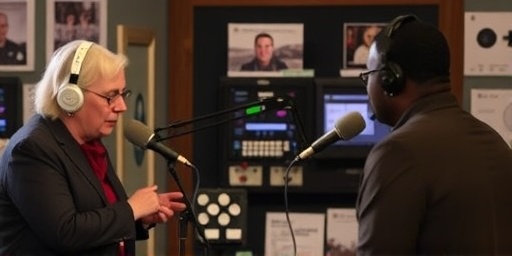In the shadow of towering mountains and vast prairies, a lifeline for rural America flickers under threat. Public radio stations, long the unsung heroes delivering emergency alerts during wildfires and floods, now face shutdowns as federal funding slashes deepen. This week, the Corporation for Public Broadcasting (CPB) announced a 25% cut to its annual budget, putting over 200 rural stations at risk of closure and igniting a fierce bipartisan debate in Washington over the soul of public media.
- Rural Listeners Left in the Dark: Emergency Services on the Brink
- Budget Battles Heat Up: How Federal Funding Cuts Unfolded
- Station Managers Sound the Alarm: Frontline Stories of Struggle
- Bipartisan Backlash Builds: Lawmakers Clash Over Public Media’s Role
- Horizons Ahead: Strategies to Safeguard Rural Public Radio’s Future
Rural Listeners Left in the Dark: Emergency Services on the Brink
Picture this: a fierce blizzard blankets a remote Wyoming town, cutting off cell service and internet. In such moments, Public radio becomes the only voice piercing the isolation, broadcasting life-saving updates from the National Weather Service. Yet, with federal funding for Public radio dwindling, these critical broadcasts could soon fall silent. According to a recent report from the Public Radio Program Directors Association, rural stations serve 57 million Americans in areas where commercial media often fails to reach, providing not just news but vital emergency communications.
The cuts, proposed in the latest federal budget reconciliation package, target the CPB’s $535 million annual appropriation, reducing it by $134 million. This isn’t abstract policy—it’s personal. In rural America, where 19% of the population lives but only 3% of media outlets operate, public radio fills a gaping void. Stations like KWRV in Idaho’s panhandle, which covers 10,000 square miles with just five staffers, rely on 40% of their budget from federal sources. “Without this funding, we’re not just losing radio; we’re losing our safety net,” says station manager Elena Torres, whose team recently coordinated evacuations during a 2023 wildfire that scorched 50,000 acres.
Statistics paint a dire picture: A 2022 GAO study found that 85% of rural counties depend on public radio for disaster information, far outpacing urban areas. The funding squeeze exacerbates existing challenges, including aging equipment and volunteer shortages. In states like Montana and Alaska, where geography amplifies isolation, the loss could be catastrophic. Listeners, from farmers tuning in for crop reports to elders seeking companionship, voice their fears. “Public radio is our connection to the world,” shares 72-year-old rancher Tom Reilly from Nebraska. “If it goes, so does a piece of who we are.”
This crisis underscores the unique role of public radio in rural America, where politics and media intersect to shape daily survival. As debates rage, the human cost mounts, with stations already trimming programs and staff to stay afloat.
Budget Battles Heat Up: How Federal Funding Cuts Unfolded
The path to these cuts traces back to partisan wrangling in Congress, where fiscal conservatives pushed for trims to non-defense spending amid rising national debt concerns. Last month’s House Appropriations Committee vote passed a bill slashing CPB funds by 25%, citing redundancies in the digital age. Proponents, led by Rep. Mike Johnson (R-La.), argue that streaming services and podcasts have diminished the need for subsidized broadcasting. “Taxpayers shouldn’t foot the bill for media that competes with private enterprise,” Johnson stated during floor debates.
Yet, the reductions hit hardest where private media shies away—rural America. The CPB, established by the 1967 Public Broadcasting Act, distributes funds to over 1,400 public radio and TV stations, with rural ones receiving a disproportionate share due to their high operational costs per listener. In fiscal year 2023, federal funding accounted for 15% of public radio’s total revenue, but for small rural stations, it’s often 50% or more. The proposed cuts could force closures in 15 states, per estimates from the National Public Radio (NPR) affiliate network.
Behind the numbers lies a web of economic pressures. Rural stations operate on shoestring budgets—averaging $300,000 annually compared to urban counterparts’ $5 million—making them vulnerable to fluctuations in federal funding. A 2024 analysis by the Benton Institute for Broadband & Society revealed that without CPB support, 30% of rural public radio outlets would shutter within two years, eroding local journalism in regions already plagued by news deserts.
Politics amplifies the tension: Democrats decry the cuts as an assault on underserved communities, while some Republicans see them as streamlining government. This federal funding fiasco highlights broader media challenges, where public radio’s non-commercial model clashes with market-driven ideologies.
Station Managers Sound the Alarm: Frontline Stories of Struggle
From the dusty studios of Kansas to the foggy coasts of Maine, public radio station leaders are rallying against the funding tide. In rural Vermont, WDEV’s owner, who doubles as a morning host, has launched a crowdfunding campaign after federal allocations dropped 20% last quarter. “We’re bleeding listeners who can’t afford donations,” he laments, noting a 15% dip in pledge drives since the cuts began.
Take KGLR in Michigan’s Upper Peninsula, a station that serves 300,000 residents across 16 counties. Manager Sarah Kline recounts how federal funding helped upgrade transmitters post-2022 floods, enabling alerts that saved dozens of lives. Now, with budgets halved, they’ve cut classical music programs and local news segments. “Politics in Washington feels worlds away, but it’s closing our doors,” Kline says. Her station’s story mirrors hundreds: A survey by the Corporation for Public Broadcasting found 62% of rural affiliates planning staff reductions, with 40% eyeing program cancellations.
Listeners’ testimonials add emotional weight. In Oklahoma, where tornadoes are a seasonal menace, retiree Maria Gonzalez credits public radio for guiding her family to safety during a 2023 twister. “It’s not entertainment; it’s essential,” she insists. Community events, like town halls broadcast live, foster bonds in isolated areas, but funding woes threaten these lifelines. One innovative response: Partnerships with local co-ops, where stations trade airtime for sponsorships, though these can’t fully replace federal support.
These narratives reveal public radio’s resilience amid politics and media shifts, but without intervention, rural America’s informational backbone could fracture irreparably.
Bipartisan Backlash Builds: Lawmakers Clash Over Public Media’s Role
The funding cuts have fractured party lines, drawing unlikely allies in defense of public radio. Sen. Amy Klobuchar (D-Minn.), representing vast rural districts, co-sponsored a Senate amendment to restore CPB funds, arguing, “In rural America, public radio isn’t a luxury—it’s democracy in action.” Her Republican counterpart, Sen. Jerry Moran (R-Kan.), joined the effort, highlighting how stations in his state deliver agribusiness news crucial to 40% of Kansas’s economy.
This bipartisan push counters the House’s austerity measures, with a Senate hearing last week featuring testimony from NPR CEO Katherine Maher. “Federal funding leverages every dollar eightfold through local contributions,” Maher testified, citing data showing $1 in CPB grants generates $7 in community support. Critics, however, including the Heritage Foundation, label public media as outdated, pointing to NPR’s $300 million endowment as evidence of self-sufficiency.
Politics permeates the debate: Urban-rural divides play out, with city lawmakers less attuned to rural media needs. A Pew Research poll indicates 70% of rural residents value public radio for local coverage, versus 45% in suburbs. Advocacy groups like the Future of Public Media coalition have mobilized, gathering 50,000 petition signatures urging President Biden to veto any budget with deep cuts.
As negotiations intensify, the clash exposes tensions in American media policy, where federal funding decisions could redefine access to information in underserved regions.
Horizons Ahead: Strategies to Safeguard Rural Public Radio’s Future
Looking beyond the immediate crisis, stakeholders eye multifaceted solutions to bolster public radio’s endurance. Enhanced state-level funding emerges as a key pillar; states like California and New York have increased appropriations by 10% in recent years, offering a model for others. Rural America could follow suit, with governors in Iowa and Colorado proposing bills to offset federal shortfalls through dedicated media trusts.
Digital innovation provides another avenue. Many stations are pivoting to hybrid models, streaming apps and podcasts to attract younger donors while preserving over-the-air signals for emergencies. The CPB’s Digital Radio Initiative, though underfunded, has helped 200 rural outlets launch apps, boosting listenership by 25% in pilot areas. Collaborations with tech giants, such as Verizon’s rural broadband expansion, could integrate public radio into 5G networks, ensuring reach without sole reliance on federal funding.
Policy reforms loom large: Bipartisan bills like the Public Media Reinforcement Act aim to index CPB funding to inflation, preventing future erosions. Advocacy continues, with town halls and listener drives planned nationwide to pressure lawmakers. If successful, these efforts could not only stabilize stations but enhance their role in combating misinformation in rural America.
Ultimately, the fate of public radio hinges on recognizing its indispensable place in the media landscape. As debates evolve, the push for sustainable support promises to shape a more equitable future for information access, ensuring rural voices endure amid political tempests.








